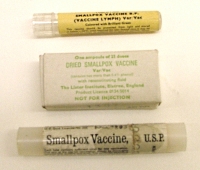Allergy & Immunity - Vaccination
Smallpox
 Image left: Smallpox vaccines (Tayside Medical History Museum, DUNUC 7803, 8533, 8534)
Image left: Smallpox vaccines (Tayside Medical History Museum, DUNUC 7803, 8533, 8534)
It had been known for centuries that survivors of smallpox outbreaks were protected from subsequent infection. Attempts to ward off the disease by inducing a minor form of it was called variolation. This involved inhalation of the dried crusts from smallpox lesions or inoculation of the pus from a lesion into a scratch on the skin. These were potentially hazardous procedures, yet deemed acceptable at the time as smallpox caused such severe mortality and morbidity.
Edward Jenner, who had himself been variolated whilst at school, famously published a careful study in 1798 showing that inoculation with cowpox protected against subsequent challenge with smallpox. His ideas were initially greeted with violent opposition, but in time Jenner achieved world fame, and his technique became universally known as vaccination from the Latin name for the cow, vacca. The practice of variolation was forbidden by Act of Parliament in 1840.

In the UK, vaccination against smallpox was made compulsory in the mid-19th century, and this led to formation of anti-vaccination leagues that challenged the law as a violation of civil liberty. However, the law was later relaxed to allow for exemption for parents based on conscience, the origin of the term ‘conscientious objector’. Anti-vaccination groups are still present in the 21st century, but there is no doubting the part played by mass vaccination in the global eradication of smallpox by 1977.
Image right: Anti-vaccination propaganda envelope, 1878 (image courtesy of Grosvenor Philatetic Auctions)
Diphtheria
 Diphtheria was another of the terrible child-killers of Victorian times, although the introduction of antitoxin therapy in the 1890s improved the case mortality considerably. In Dundee, antitoxin became more widely used after 1918, although the dose used before World War II was relatively small. Severe outbreaks occurred in 1925-7 and 1940-42, and during the latter over four thousand cases were admitted to Kings Cross Hospital.
Diphtheria was another of the terrible child-killers of Victorian times, although the introduction of antitoxin therapy in the 1890s improved the case mortality considerably. In Dundee, antitoxin became more widely used after 1918, although the dose used before World War II was relatively small. Severe outbreaks occurred in 1925-7 and 1940-42, and during the latter over four thousand cases were admitted to Kings Cross Hospital.
In 1913, Emil von Behring introduced a mixture of diphtheria toxin neutralised by antitoxin to give active immunity. This was superseded by inactivating the toxin component with formaldehyde to produce toxoid. It is perhaps surprising to read in the Dundee Medical Officer of Health’s 1929 report that the local public did not favour active immunisation (vaccination) with diphtheria toxoid-antitoxin in the light of the 1920s outbreak.
The wartime epidemic eventually led to vaccination on a serious scale. Local and national campaigns combined with good work of health visitors, GPs and public health staff resulted in over 80% of children being immunised by 1946. Diphtheria virtually disappeared from Dundee by 1950.
Image above: Post-war Diphtheria vaccination poster (private collection)
Polio
Poliomyelitis struck Dundee in 1947 with 43 cases and 4 deaths – this outbreak received considerable press coverage, although curiously less notice was taken of an outbreak of infantile gastroenteritis which killed 42 of 160 babies admitted to hospital. Polio struck again in 1950 with 157 cases and 9 deaths. Salk’s vaccine appeared in 1955, although an early faulty batch which caused 260 cases of polio and 10 deaths led to a degree of public apprehension as can be seen from newspaper reports of the time.
A further outbreak of polio occurred in Dundee in 1962, mainly in the Fintry area, with 40 cases and one death. However, a mass vaccination campaign in the city with 118,000 doses of the new Sabin oral vaccine brought the outbreak to an abrupt end.

Image above: Queuing at the Nelson Street clinic to receive the polio vaccine, 1962 (copyright DC Thomson & Co Ltd)